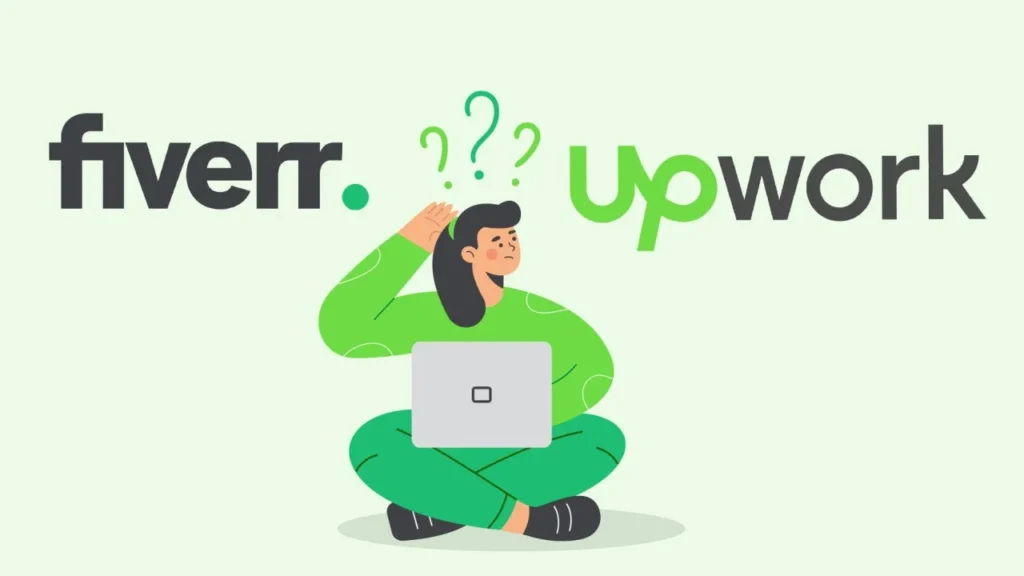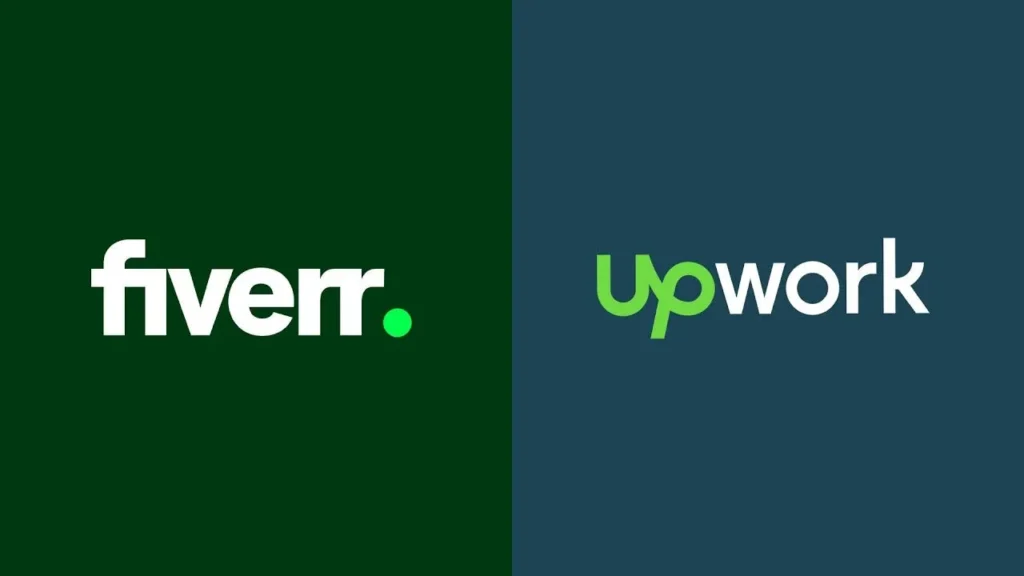🟢 Introduction
The global freelance industry has entered its golden era, with professionals and businesses increasingly relying on platforms like Fiverr and Upwork. As of 2025, both have evolved beyond simple marketplaces — they’re ecosystems shaping how modern work happens.
Yet, the question remains: Fiverr vs Upwork — which platform actually gives you the better value?
Both platforms share a common goal: connecting talent to demand. However, their execution, culture, and ideal audience are very different. Fiverr thrives on speed, simplicity, and gig-style transactions. Upwork, on the other hand, supports long-term, contract-based relationships.

1️⃣ Platform Overview: Fiverr vs Upwork
🧩 Fiverr at a Glance
Fiverr operates on a “gig economy” model where freelancers (called sellers) list services called gigs — complete with pricing tiers, timelines, and examples of past work. Clients (buyers) browse these offerings, pay upfront, and the freelancer delivers the work.
In 2025, Fiverr has expanded its suite with:
- Fiverr Pro: Verified top-tier experts for premium clients.
- Fiverr Go: A new AI-assisted program where freelancers train and license AI models using their creative input.
- Fiverr Neo: Personalized AI that matches freelancers to clients faster than before.
This makes Fiverr a top choice for fast, small-to-medium-size creative or technical jobs — such as logo design, video editing, marketing campaigns, or web development.
🧩 Upwork at a Glance
Upwork, by contrast, is built for proposal-based contracting. Clients post detailed projects or hourly jobs, freelancers send proposals with bids and cover letters, and the client chooses the best fit.
Upwork’s model supports:
- Hourly or milestone-based contracts
- Time tracking through Upwork’s app
- Long-term client-freelancer relationships
- Direct communication and file sharing
In Fiverr vs Upwork, Fiverr feels like eCommerce for services, while Upwork is more like a professional job marketplace.
2️⃣ Pricing & Fee Structures: Fiverr vs Upwork
💸 Fiverr Pricing in 2025
Fiverr takes a 20% flat commission from freelancers on every gig — whether it’s $5 or $5,000. Buyers also pay a small service fee (around 5%) when ordering.
This predictable, fixed-rate model simplifies accounting for new freelancers but can feel restrictive at higher price points. For instance, a $2,000 website design gig costs freelancers $400 in platform fees.
However, Fiverr has introduced subscription gigs, letting freelancers charge recurring monthly fees for ongoing work like SEO maintenance or social media management — expanding their earning opportunities.
💰 Upwork Pricing in 2025
Upwork’s tiered fee structure rewards loyalty:
- 20% for the first $500 earned with a client
- 10% from $500.01 to $10,000
- 5% beyond $10,000
This means that long-term client relationships become more profitable over time.
Clients don’t pay commission directly, though Upwork includes small administrative fees in its billing process.
📊 Summary:
When comparing Fiverr vs Upwork, Fiverr is simpler and faster for one-off gigs, while Upwork can be more lucrative for sustained partnerships and larger projects.
3️⃣ Talent Pool, Quality & Vetting: Fiverr vs Upwork
🎯 Fiverr Talent & Levels
Fiverr categorizes freelancers into four levels:
- New Seller – entry-level access
- Level 1 Seller – after 60 days and 10+ orders
- Level 2 Seller – consistent performance for 120+ days
- Top Rated/Pro Seller – elite freelancers, manually vetted
The Fiverr Pro program ensures vetted experts deliver verified, professional-grade results. Clients can filter by Pro level to ensure consistent quality.
🎯 Upwork Talent & Vetting
Upwork uses metrics like:
- Job Success Score (JSS)
- Client feedback and long-term earnings
- Skill badges and certifications
- Expert-Vetted program for top 1% professionals
This structure gives clients confidence that each freelancer is proven and capable.
💡 Insight:
In Fiverr vs Upwork, Fiverr’s open-entry system allows more diversity but inconsistent quality. Upwork’s tighter vetting ensures expertise but creates a steeper entry curve for beginners.
4️⃣ Workflow, Interface & Management: Fiverr vs Upwork
⚙️ Fiverr Workflow
- Clients browse gigs → select → pay → work begins.
- All communication happens within Fiverr’s messaging interface.
- Revision, delivery, and approval are streamlined.
- Auto-delivery and resolution tools reduce disputes.
Fiverr recently added Fiverr Workspace, an all-in-one business suite for freelancers to handle contracts, invoices, and analytics.
⚙️ Upwork Workflow
Upwork offers greater project flexibility:
- Clients post jobs, freelancers send proposals.
- Milestones can be created for large projects.
- Time tracking ensures clients pay only for productive hours.
- Dispute resolution and escrow protection ensure fair payments.
Its dashboard includes detailed analytics, collaboration features, and AI-driven job matching.
⚖️ Comparison:
When weighing Fiverr vs Upwork, Fiverr prioritizes speed and automation. Upwork gives users professional-grade project control suited for ongoing contracts.

5️⃣ Income Potential & Earnings: Fiverr vs Upwork
📈 Fiverr Earning Potential
Fiverr allows freelancers to sell multiple gigs simultaneously — increasing visibility and income sources. Top-rated sellers often make $5,000–$20,000/month depending on niche and consistency.
However, the constant 20% cut reduces high-end profit margins. Also, competition in popular categories like logo design or writing means new sellers may struggle initially.
💼 Upwork Earning Potential
Upwork favors freelancers building long-term client relationships. Successful Upworkers frequently exceed $100,000/year as consultants, developers, or designers.
Because of tiered fees, earnings grow more efficient over time. Hourly contracts also ensure predictable income flow, unlike Fiverr’s per-gig volatility.
🔍 Verdict:
For Fiverr vs Upwork, Fiverr offers fast starts but limited scalability. Upwork is ideal for professionals seeking long-term, high-value engagement.
6️⃣ Pros & Cons: Fiverr vs Upwork
| 🔍 Feature | Fiverr – Pros | Fiverr – Cons | Upwork – Pros | Upwork – Cons |
|---|---|---|---|---|
| Ease of Use | Simple, no bidding | Highly competitive | Advanced controls | Proposal writing required |
| Entry Barriers | Very low | Quality inconsistency | Strict vetting = trust | Harder for beginners |
| Payment Security | Upfront escrow | Commission fixed at 20% | Milestone escrow | Occasional delayed disputes |
| Project Type | Short, creative tasks | Not ideal for long-term | Long-term, flexible | Overkill for small jobs |
| Support & Tools | Instant chat, Fiverr Workspace | Limited analytics | Time tracking, AI job match | Interface learning curve |
| Brand Growth | Easy profile building | Lower average prices | Portfolio building possible | Proposal fatigue |
In short, Fiverr vs Upwork represents the trade-off between simplicity and professionalism, speed and scalability, and quantity vs quality of clients.
7️⃣ Use Cases: When to Choose Fiverr or Upwork
✔️ Choose Fiverr If:
- You want quick tasks done (logo, blog, animation, translation).
- You prefer straightforward pricing with no negotiation.
- You’re a new freelancer testing your services.
- You enjoy selling multiple packages to diverse clients.
✔️ Choose Upwork If:
- You want to build ongoing professional relationships.
- You handle complex, high-value projects (software, consulting).
- You prefer hourly contracts or recurring retainers.
- You want AI-assisted tools for project management.
Example:
A YouTuber needing quick thumbnails → Fiverr.
A startup needing a full-time remote developer → Upwork.
Thus, in Fiverr vs Upwork, the right choice depends on your project’s depth, frequency, and budget.
8️⃣ 2025 Trends: AI, Automation & the Future of Freelancing
The Fiverr vs Upwork competition is rapidly influenced by AI and automation in 2025.
🤖 Fiverr’s AI Push
Fiverr’s Go and Neo initiatives focus on AI-empowered creativity. Freelancers can now build and monetize trained AI models — for instance, selling AI-generated voiceovers, templates, or image filters.
Fiverr’s 2025 update also includes personalized buyer recommendations powered by machine learning, helping clients find ideal sellers faster.
🧠 Upwork’s AI Expansion
Upwork has rolled out UMA (Upwork Machine Assistant), which helps freelancers write proposals, generate job matches, and track milestones. It can even evaluate past performance to suggest pricing improvements.
💹 Market Outlook
The global freelance economy surpassed $1.9 trillion in 2025, and both Fiverr and Upwork lead the charge. New features like crypto payments, AI gig creation, and hybrid subscription models are making freelancing more sustainable than ever.
As automation increases, freelancers focusing on creative strategy, emotional intelligence, and niche expertise will thrive — regardless of whether they choose Fiverr or Upwork.

✅ Conclusion
The Fiverr vs Upwork debate in 2025 isn’t about which platform is better — it’s about which platform is better for you.
- Fiverr: Perfect for small projects, beginners, and those who want simplicity, speed, and gig-style earning.
- Upwork: Ideal for professionals seeking serious clients, recurring contracts, and scalable income.
If you’re just starting out, test Fiverr to build your portfolio quickly. Once you’re established, consider Upwork for higher-end projects.
Ultimately, both platforms can coexist in your freelance strategy. Many successful professionals use Fiverr for side projects and Upwork for main contracts — leveraging both ecosystems for maximum reach.
In 2025 and beyond, your success in Fiverr vs Upwork will depend not on the platform, but on how strategically you position your skills within it.
🔗 External References & Resources
- Fiverr Official Website
- Upwork Official Website
- Upwork vs Fiverr Comparison – StealthAgents
- Fiverr vs Upwork 2025 Report – Wishup Blog
- Freelancing on Fiverr vs Upwork – Medium
- Upwork vs Fiverr – The Verge Analysis
- Fiverr AI Expansion – Windows Central
Also Read: Ultimate Guide 2025: Discover the Best Freelance Rates Per Hour in the UAE to Boost Your Income


One thought on “Fiverr vs Upwork 2025 – The Ultimate Honest Comparison You Need Before Freelancing”